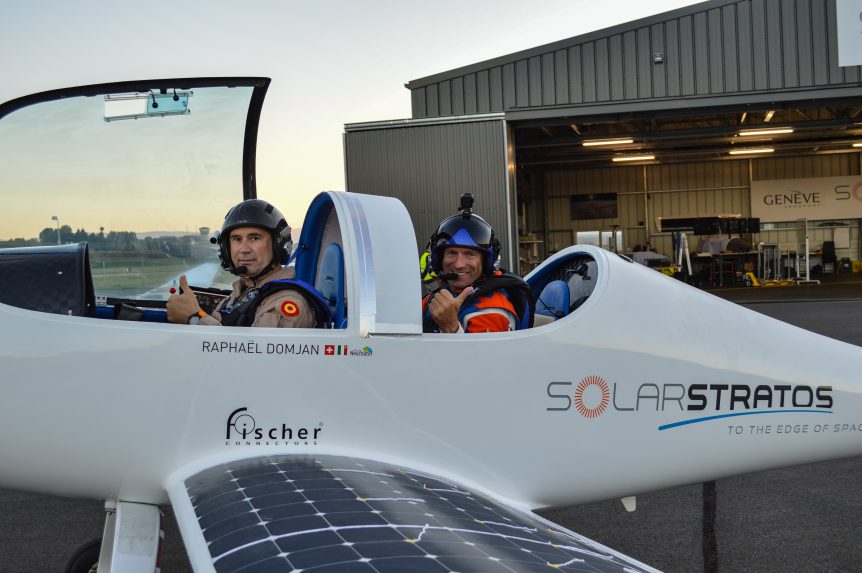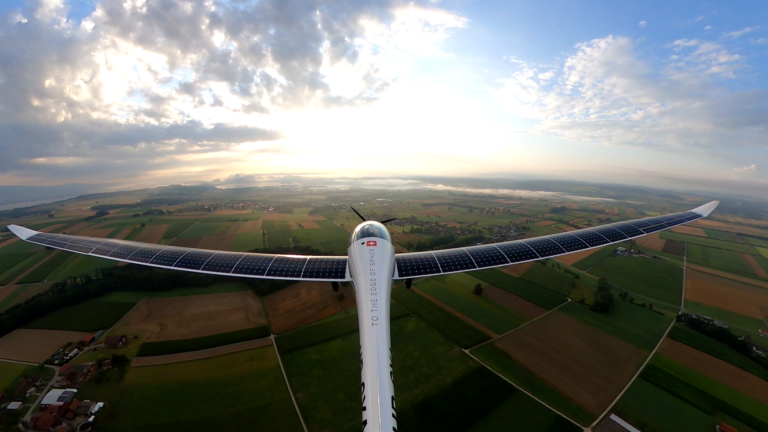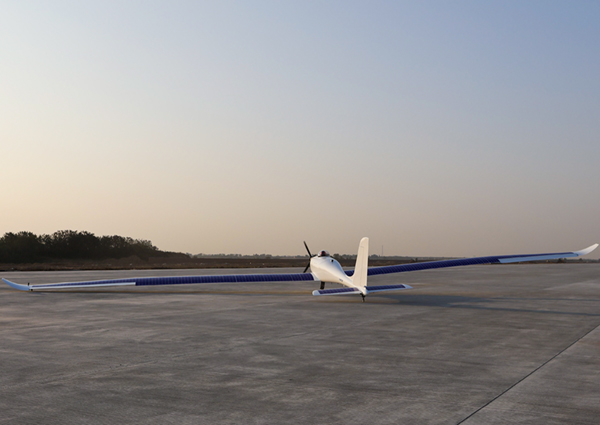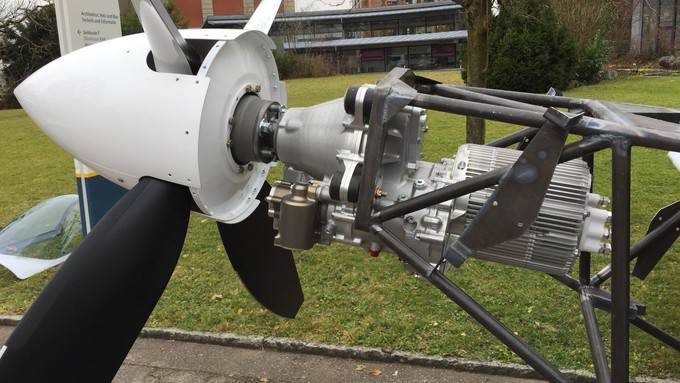If you happen to be in Payerne, Switzerland tomorrow morning around 7:00 a. m. Tuesday morning, August 25, you might want to visit the local airport. There, the SolarStratos team will stage a demonstration flight with a free fall parachute jump by the project’s founder. Miquel Iturmendi will pilot Raphael Domjan to an unspecified height, from which Domjan will depart the aircraft and free fall, open his parachute, and join the gathered throng. Iturmendi will presumably return the airplane shortly thereafter. We’re not sure whether this flight will be available for Cockpit Virtuel viewing, but future expeditions should have that feature, much like the Perlan Project’s world altitude record ventures. Iturmendi was co-pilot on one run to 65,000 feet. This video, just a few days old, shows the airplane ready for its dual-occupant flight. In true cinema verite’ style, it forgoes narration and soundtrack music, allowing us to hear the ambient sounds of SolarStratos. A retrospective of past trials and …
SolarStratos Returns to Service
SolarStratos, a mission envisioned by Raphaël Domjan and an airplane designed by Calin Gologan, returns to the skies after suffering a literal break in its program in 2018. During a series of tests that put increasingly heavy loads on the wings, its left wing broke with what was called a “technical damage.” This type of breakage during stress testing is not uncommon, especially on what are special machines such as SolarStratos and Solar Impulse. Solar Impulse 2 suffered a similar break when its newly-designed wing was being tested. As noted, this type of setback takes the team back to the drawing board, but also besets them with new reflections on their ongoing decisions. If it were easy, everyone would be doing it. “This pioneering spirit involves a real technological challenge, and takes us to unknown territories. Risks are an integral part of such a project, even if our objective is to anticipate them as well as possible; this is why …
Fred To Receives a Well-Deserved Award
Fred To (pronounced Toe) lives in England and was one of a small group who built and flew the world’s first solar-powered airplane in December 1978. They flew just a few months before Larry Mauro lofted his solar-riser in April 1979. Both airplanes were limited by the technology of the day, lithium-ion batteries still over a decade away, and the best solar cells achieving less than five-percent efficiency. Fred wrote to tell your editor of the award. “I was in Montreux Switzerland a few weeks ago, and on the 22nd of October I received an award from prince Albert II of Monaco for Solar One, which is now formally accepted as the first solar powered aircraft to fly. It was a great occasion and my family are so proud. All the great past pioneers were there and it was an honor to meet them; now I have new friends from all over the world. ” The occasion, described on Raphael …
Elektra Solar Launches HALE with Autonomous Control
Dr. Birgit Weißenbach of Elektra Solar GmbH and PC-Aero announced “The world’s strongest multifunctional solar-electric HALE aerial vehicle – the Elektra Two Solar: [with] “Take-off, flight and tough-down” successfully completed with [its] own autopilot system We usually think of HALE (High Altitude Long Endurance) aircraft as being huge, sun-eclipsing things like AeroVironment’s flying wings or Boeing’s Phantom Eye. These require large support systems and ground crews, much like the team that chased Solar Impulse around the world. Elektra Solar GmbH, a joint venture combining PC-Aero GmbH and Elektra UAS GmbH, uses aircraft designed by Calin Gologen, head of PC-Aero, and computer technology from Dr. Ing. Habil. Konstantin Kondak. Since October, 2009 he headed a key research area, Flying Robots at DLR’s Institute of Robotics and Mechatronics in Oberpfaffenhofen near Munich. Their collaboration led to two svelte HALEs, the smaller Elektra One Solar (a veteran of a solar-powered Alpine crossing) and the larger Elektra Two Solar. This airplane is also the …
SolarStratos Damaged During Testing
A terse announcement from the SolarStratos project last week caused some dismay in your editor, but also gave hope that a brave project would go forward. “Payerne, July 6, 2018 – the solar stratospheric SolarStratos aircraft damaged this morning during a resistance test on Earth, in the base of the team at Payerne. No risk:” The bad news, “However, the wing was damaged and its repair will cause a delay in the team’s operational schedule,” was reminiscent of a failure of the Solar Impulse’s wing during static testing. The break set that project back over a year but resulted in a wing that carried Solar Impulse 2 to Morocco and back, across the U. S., and finally, around the world. Raphael Domjan, founder of the SolarStratos project, takes a philosophical view of the setback. “Our plane is a unique prototype, destined to accomplish what nobody has done so far: fly to the stratosphere in a clean way, thanks to solar …
SolarStratos Makes First Flight
SolarStratos, a feather-light 450 kilogram (990 pound), solar-powered airplane, lifted off for the first time on May 5 in Payerne, Switzerland. Considering its 24.9 meter (81.69 feet) wingspan, the airplane shows designer Calin Gologan’s ability to squeeze performance from every gram of structure. It flies nicely, too, with test pilot Damian Hischier enthusing, “The plane is very nice to [fly]. [Its] reactions are healthy, and we see that it was well designed.” Sharing Payerne Airport with Solar Impulse, SolarStratos represents a different kind of adventure, ready to make five-hour flights to 75,000 feet (two hours up, five hours down). Such flights can carry a pilot and scientific measuring equipment, or for those lucky enough to have the price of admission, a passenger. Passengers on this high stratospheric journey will need to wear a pressure suit, and undoubtedly undergo hours of training on how to behave at such altitudes. The Pulse reports, “Until now, reaching the stratosphere has required large quantities …
Smartflyerchallenge – Europe’s First Fly-In for Electric Powered Aircraft
Air meets have been an important part of aviation history, bringing pilots, planes nad the public together in a symbiotic gathering. This was true in aviation’s genesis; things gaining a tremendous impetus with air meets throughout Europe and America following Wilbur Wright’s 1908 public demonstrations near Le Mans, France. René Maier, ex-Colonel of the Swiss Army and current President of the newly formed organization team for an annual event organized at the Grenchen Regional Airport, has announced the SmartFlyer Challenge, touted as the first fly-in for electric aircraft. The event, to be held September 9 and 10, 2017, will make Grenchen “the center of electric flight,” according to the organizers. Static and air displays of electric and hybrid-electric powered aircraft will help drive that message home. Organizers advertise at least four aircraft scheduled to appear, including an electrified Votec 221 being prepared by a group of university students at Innocampus Biel at the Bern University of Applied Sciences, Hangar 55’s Hamilton …
EAS IX: Calin Gologan Talks SolarStratos
Calin Gologan, founder and CEO of PC-Aero GmbH, has many electric and solar-assisted aircraft flying right now, and is responsible for the design the Aero Electric Aircraft Company’s SunFlyer training airplane, 20 of which have been ordered by Spartan Aeronautical University. The initial Elektro One has flourished in a number of variants, including the SunFlyer, a two-seat, side-by side trainer developed with George Bye in Colorado. Another variant of that original design, Solar Stratos is destined to combine record-setting altitudes with scientific research. Its banner, “Manned Flight at the Edge of Space,” highlights the craft’s intended mission to reach 80,000 feet as its initial goal, a record that will be hard to beat. Its mission is also a research venture, with Calin serving as Chief Technology Officer of SolarStratos. The initiator of SolarStratos, Raphaël Domjan, is now paddling his way through an Arctic Passage in one of two solar-powered kayaks, accompanied by Anne Quéméré, described as a Breton sailor. Their …
It’s (Green Aviation) Giving Tuesday, 2014
If you’ve managed to survive Gray Thursday, Black Friday, and a weekend of NFL games stuffed with blandishments to entice you to the nearest mall (Thanksgiving happened in there somewhere), you’re forgiven if you flinch at yet one more presumptuous tug at your purse strings. But we’re talking about helping pioneers on the edge of green technology, crafting the stuff dreams are made of – and making those dreams a reality. On this Giving Thursday, think about contributing to the dream makers who are taking us into a better future of flight. We share a few suggestions here. Solar Flight Eric and Irena Raymond are the first family of solar-powered flight, now cruising Italian skies in the world’s first two-seat sun-powered airplane, the Duo. To assist with further development of their splendid aircraft, including Sunstar, a high-altitude surveillance and communications craft, the couple is selling a beautiful calendar featuring their aircraft. For $37 US or 29 euros plus shipping, you …
SolarStratos Construction to Begin in January
Just as we have competing teams working out their plans to cross the Atlantic on electrically-powered wings, several projects are aiming high, attempting to reach altitudes normally achieved only by SR-71 pilots. With balloon jumps topping 130,000 feet and the Perlan Project in final stages of construction for test flights early next year, the latest entrant in stratosphere-busting climbs will attempt the mission on batteries and solar power. Raphael Domjan, a self-described “eco-adventurer” and founder of Mission SolarStratos, will attempt by 2017 to top 80,000 feet in a two-seat, twin-motored craft designed and built by Calin Gologan and his PC-Aero team. The airplane, a long-winged derivation of Gologan’s Elektra Two Solar, will rely on recent developments between Gologan and his American Partner, George Bye. They’ve formed the American Electric Aircraft Corporation, dedicated to building, testing and certifying a two-seat trainer. Solar Stratos has a 24.4-meter (80.8 feet) wing, 7.4 meters (9.84 feet) longer than that on the longest-span Elektra Two. …
- Page 1 of 2
- 1
- 2







